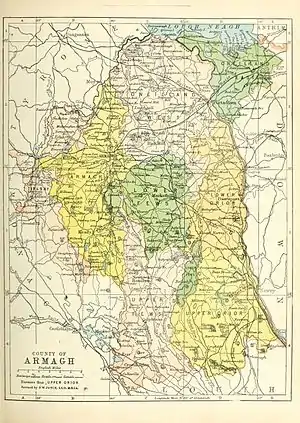Mountnorris
| |
|---|---|
 Main Street | |
 Mountnorris Location within Northern Ireland | |
| Population | 155 (2011 Census) |
| Irish grid reference | H995348 |
| • Belfast | 40 mi (64 km) |
| District | |
| County | |
| Country | Northern Ireland |
| Sovereign state | United Kingdom |
| Post town | ARMAGH |
| Postcode district | BT60 |
| Dialling code | 028, +44 28 |
| Police | Northern Ireland |
| Fire | Northern Ireland |
| Ambulance | Northern Ireland |
| UK Parliament | |
Mountnorris is a small village and townland in County Armagh, Northern Ireland. The village also extends into the townland of Tullyherron. It lies about six miles south of Markethill. It is within the Armagh, Banbridge and Craigavon local government area. It had a population of 155 people (79 households) in the 2011 Census.[1] (2001 Census: 165 people)
History
The townland of Mountnorris was historically called Aghnecranagh and Aghenecranagh (from Irish Achadh na Cranncha 'field of the wooded place').[2] In 1600 Lord Mountjoy built an earthwork fort and left a garrison of 400 men under the command of Captain Edward Blaney in Mountnorris. The area took its name by combining the names of Mountjoy and his campaign commander in the Low Countries, Sir John Norris.
By 1620, the village no longer had a garrison and in the 18th century passed into the hands of the Cope family of Loughgall, to become a rural settlement with no military connections. The village was the originally intended site of the Royal School but due to instability at the time in Ulster, the school was resituated to its current site in Armagh and was opened in 1608.
On 31 May 1991, during "The Troubles", the Provisional IRA carried out a large truck bomb attack against the British Army (Ulster Defence Regiment) base at nearby Glenanne. It killed three soldiers and wounded another ten. It is often called the "Glenanne barracks bombing".
Climate
| Climate data for Glenanne climate station (161m elevation), 1981–2010 normals | |||||||||||||
|---|---|---|---|---|---|---|---|---|---|---|---|---|---|
| Month | Jan | Feb | Mar | Apr | May | Jun | Jul | Aug | Sep | Oct | Nov | Dec | Year |
| Mean daily maximum °C (°F) | 6.8 (44.2) |
7.1 (44.8) |
9.2 (48.6) |
11.5 (52.7) |
14.5 (58.1) |
17.0 (62.6) |
18.7 (65.7) |
18.3 (64.9) |
15.9 (60.6) |
12.4 (54.3) |
9.1 (48.4) |
6.9 (44.4) |
12.3 (54.1) |
| Mean daily minimum °C (°F) | 1.7 (35.1) |
1.8 (35.2) |
2.8 (37.0) |
4.2 (39.6) |
6.5 (43.7) |
9.3 (48.7) |
11.2 (52.2) |
11.1 (52.0) |
9.2 (48.6) |
6.7 (44.1) |
4.0 (39.2) |
2.2 (36.0) |
5.9 (42.6) |
| Average rainfall mm (inches) | 108.9 (4.29) |
74.9 (2.95) |
84.5 (3.33) |
74.5 (2.93) |
68.3 (2.69) |
64.6 (2.54) |
74.7 (2.94) |
82.7 (3.26) |
77.5 (3.05) |
104.8 (4.13) |
100.0 (3.94) |
103.2 (4.06) |
1,018.7 (40.11) |
| Average rainy days (≥ 1.0 mm) | 16.2 | 12.4 | 15.4 | 13.0 | 12.4 | 12.0 | 12.8 | 13.2 | 12.5 | 15.8 | 15.8 | 15.2 | 166.6 |
| Source: metoffice.gov.uk[3] | |||||||||||||
People
- Andrew Trew Wood (1826–1903), a Canadian businessman and parliamentarian, was born in Mountnorris.
- David James McEwen was born in Mountnorris in 1863, son of the Presbyterian Minister, Reverend William McEwen. David James McEwen was raised at Rosehill in Mountnorris until 1889, when he emigrated to Australia. By 1895 he owned and operated the Pharmacy in Chiltern, Victoria and in 1900 he and his wife Sarah (née McMillen) had a son, John McEwen, who would become the 18th Prime Minister of Australia.
- Billy Wright (1960–1997, the loyalist paramilitary leader, was raised in Mountnorris. He founded the Loyalist Volunteer Force (LVF) in 1996 and was assassinated in 1997 by the Irish National Liberation Army (INLA).
Education
- Mountnorris Primary School
- St. Teresa's Primary School
References
- ↑ "Mountnorris". Census 2011 Results. NI Statistics and Research Agency. Retrieved 30 April 2015.
- ↑ Placenames NI Archived 17 March 2012 at the Wayback Machine
- ↑ "Climate Normals 1981–2010". Met Office. Retrieved 25 February 2021.
